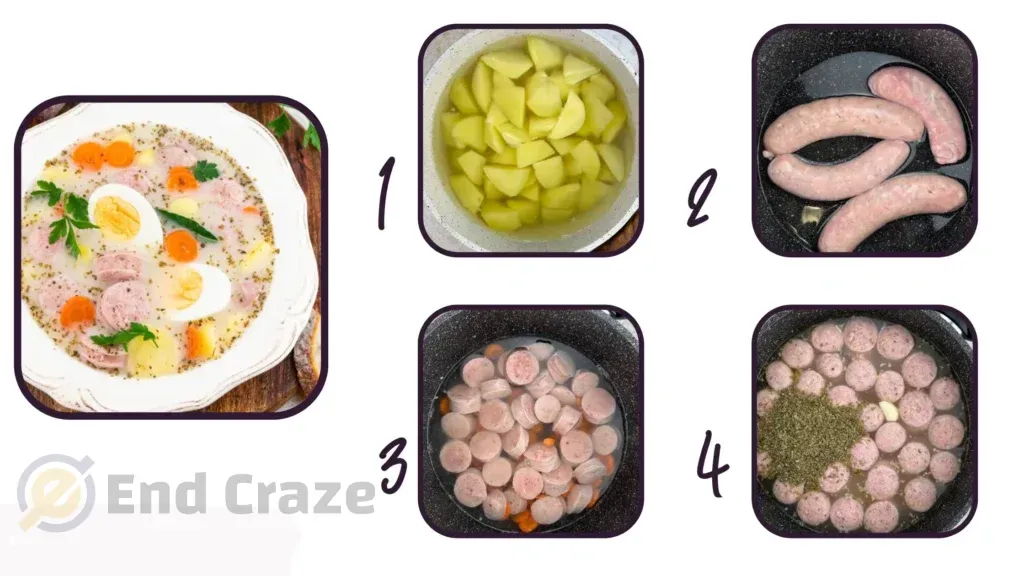This is my tried-and-true recipe for a simple homemade white bark that can be created with bought bark or homemade vinegar. I’m using white sausage and potatoes to make this barch. It will be perfect for more than just the Easter break.
Ingredients:
- Four roughly 400-gram pieces of raw or roasted white sausage
- 500 milliliters of homemade or store-bought white Borscht leaven
- 500 grams of potatoes, or roughly four medium servings
One carrot, roughly 100 grams in size. - Four glasses of water per liter;
- 50 milliliters of either 18% or 30% sweet cream;
- Spices: half a teaspoon pepper, one tablespoon marjoram, and one and a half teaspoons salt;
- Served with bread, hard-boiled eggs, and parsley.
white borscht
I have 250 milliliters in my glass. The quantity of components I listed for white bark should be cooked in a pot that holds roughly three liters.
Before being rubbed or prepared in any other way, vegetables are weighed. Every time I use fruits and vegetables, I weigh them and record them. You are not, however, required to adhere to exact grammatical rules. The weight is intended to facilitate the process of estimating the approximate quantity required to prepare a meal.
My calculations of calories were based on the foods I used. Because of this, the number of calories in this quantity is merely an estimate, as the amounts of the products you use might differ from mine. You can make roughly 2500 ml, or 5 serves, of white borscht with the ingredients listed. I estimated the calorie content of white borscht without accounting for other ingredients like bread or eggs.
To ensure you are ready for the next steps of preparation, I advise you to read the recipe from beginning to end before beginning to create white bark on acid.
I suggest making white bark using my homemade method for white bark acid.
Recipe for white borscht
Grind the 500 grams of potatoes finely and chop them into small bits, much like you would with most soups. Transfer the potatoes to a little basin. Drench them with one teaspoon of salt after dousing them with two glasses (500 ml) of water.
Cover the porch with a cover. Simmer the potatoes until they are almost tender. Ten to fifteen minutes might pass. Place the potatoes and water off to the side. While you’re preparing the barch, add everything—potatoes and prepared water—to the main pot.
400 grams of uncooked white sausage should be rinsed in cold water. Sort each cluster into its own category. Prick each piece a few times, very lightly. The sausage should be put in a big pot. Add 500 ml, or two cups, of water. Close the pot’s lid. Increase the burner power from the standard setting.
After bringing the water to a boil for no more than five minutes, take the pot off the burner for a bit. The sausage on the plate should be eaten. If the sausage is easily removed from each bunch, do so. Next, cut it into pieces no wider than 2 cm. Return the thick sausage pieces to the saucepan with the water; at this stage, you can take the shrimp (or the sliced protein) out of the water. Add the strawberries to the bowl after they have been chopped, rubbed, or sliced thinly. Simmer the carrots for around ten minutes, covered, on low heat, or until they are tender.
Advice: If you have a baked white sausage, slice it thickly right away and place it in a saucepan with water and carrots rather than baking it. You can use any kind of sausage in place of the white ones, such as brock or rustic sausages. However, I only make white shrimp with white sausage. Carrots cook more quickly in the rough sausage bowl, getting softer as the slices get thicker.
Next, add 500 milliliters of wheat acid to the boiler with white bark. Recall that you add ingredients (from an acid dish or bottle) to both flour and water. As a result, I suggest that you fully combine the contents of the container before adding the acid to the juice. If you are not using homemade acid, you are utilizing bottle acid, which comes in 500-ml bottles.
Stored in refrigerators, this food is referred to as “white bark.” For making vinegar or barch, wheat flour should be utilized. While some will have mayrake, some won’t. It isn’t very significant.
Add half a teaspoon each of salt and pepper and a tablespoon of marjoram to a pot of boiling water with the almost-soft potatoes. Once the soup has been combined and brought to a boil, turn down the burner power to ensure it boils gently (without covering). Stir the white borscht continuously for no more than five minutes. It ought to get a little thicker after that.
Advice: You can also top bread and potatoes with little bits of raw or steamed smoked bacon.
In order to keep the bark from sinking into the pot and to give it a more delicate flavor, add 50 ml of 30% beating cream or sweet, rare cream at the end. If you would like 18% sour cream instead, you can boil around 50 grams (two solid tablespoons) of cream and pour it into a small dish. Pour the hot bark into the cream to solidify it. Add the blended cream and bark to the saucepan. Mix the items thoroughly every time.

Try the bark after you’ve added the cream or sour cream to see whether you need to add more salt or pepper. You can easily add extra chicken or a teaspoon or a tooth of chopped garlic.
I recommend serving hard-boiled eggs and fresh bread with white Easter bark, but not just that. I recommend using fresh herbs like oregano, parsley, shrimp, and lubrication.
White sourdough borscht reheats well before serving. Refrigerate for a maximum of four days after storing.


